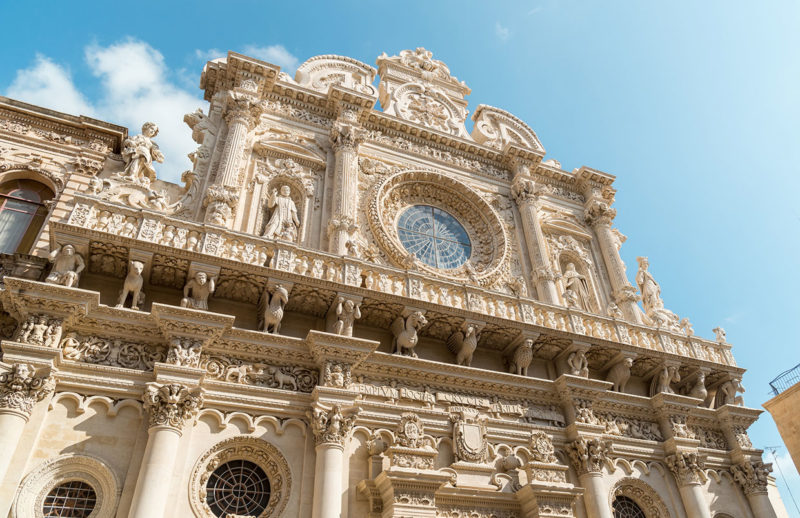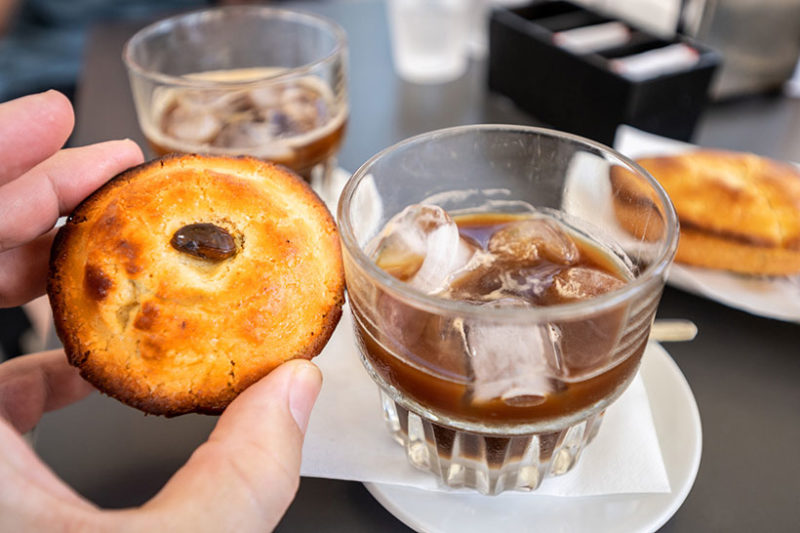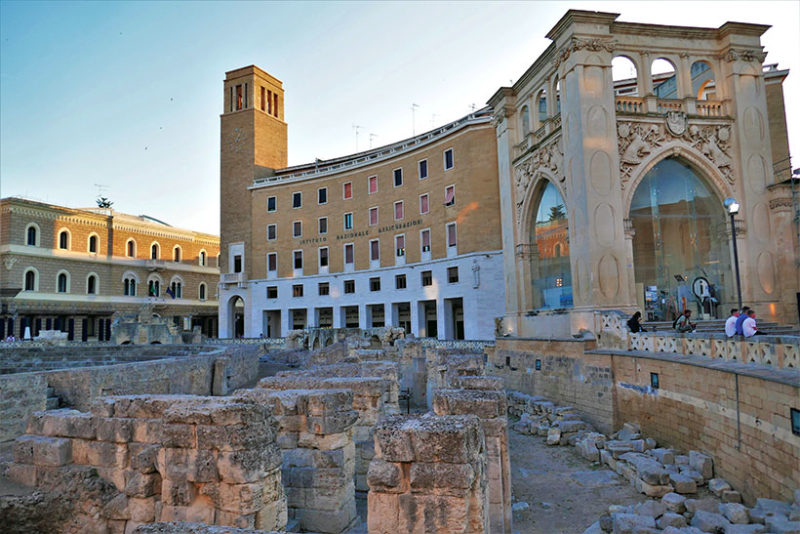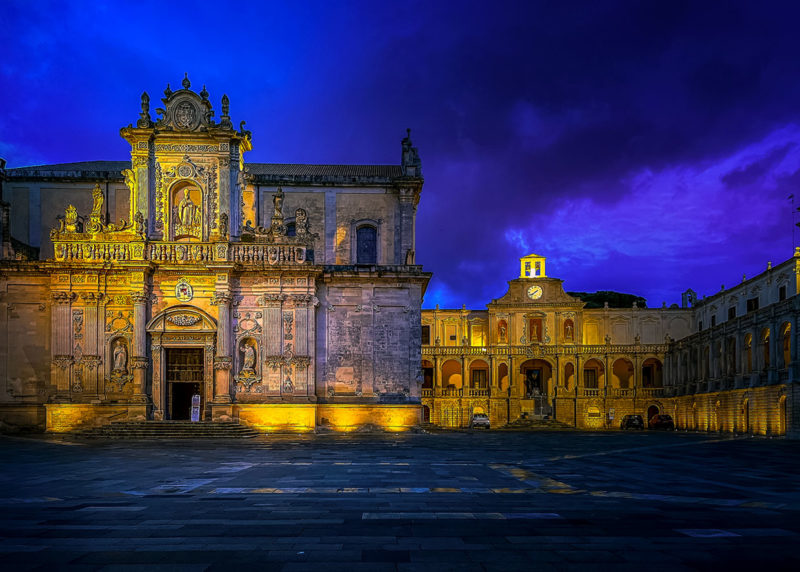Amy McPherson takes a tour around the baroque city of Lecce in Puglia and discovers that there is a lot more to the ‘Florence of the South’ than meets the eye

It seems that I am eating all the time in Lecce, which I find makes it appropriate to use this simile: Lecce is like the pastry flakes of a sfogliatella.
There isn’t one thing in the city where you can say, “This is Lecce”. It is layer upon layer of history, culture and experiences that, when someone asks you, “What do you love most about Lecce?” you find yourself quite tongue-tied looking for a straight answer.
The city is beautiful. So beautiful that it is affectionately nicknamed ‘the Florence of the South’ as well as ‘Lady of Baroque’, after the stunning baroque architecture that seems to define the city.
But delve a little deeper into Lecce (literally, below ground level) and you’ll find Roman remains and even older geological treasures that surface right before your eyes.
On a day trip organised by Palazzo Ducale Venturi, a luxury hotel thirty a minute drive from Lecce, I got to peel back the layers one by one, until the moment when I realised that, just like the sfogliatella, it is in fact, the whole of Lecce with all its layers that makes the whole – that is its attraction. But not before we’ve had coffee.
Caffè Leccese
I met my guide, Angela Venturi, at Porta Napoli, one of Lecce’s three main city gates.
I told her I wanted an authentic Lecce experience and she promptly led me to Caffè Cittadino for a local summer coffee speciality: caffè leccese, which is espresso poured over ice and dashed with sweet almond milk.

As I sip on this cup of iced goodness, Angel also orders a pasticciotto for me to snack on.
“You know this is one of the first-ever cafés in Lecce; it opened in 1720,” she said as I gorged on the pastry, filled with cream and made a mess.
Like everything in Lecce, the pasticciotto (derived from pasticcio, a mess) comes with a story.
This one is about a chef for a noble family who wanted to impress their rivals. Having laboured for hours, he ran out of time and created little mini-cakes from the leftovers of other trials.
The resulting pastry was so good that when he was asked about its name, he panicked and said, “But it’s just a big mess!”
Lecce in layers
Like most people, I begin my tour of Lecce from the lively Piazza Sant’Oronzo and find that the city does in fact, come in layers.
The excavated Roman amphitheatre is the centrepiece, decorated with a baroque triumphal arch among the modern cafés and boutiques that outline the square. The Piazza is, essentially, Lecce history in one panorama.
While it isn’t uncommon to come across Roman ruins in Italy, what is interesting about Lecce’s amphitheatre is that it is ‘underground’, and was completely out of sight – and forgotten – till it was discovered in the 1900s by construction workers who were digging in the area to build a bank.
It seems that all things Roman were built on top of and forgotten about in Lecce, as was evident once again at another Roman theatre along a narrow alleyway behind Chiesa di Santa Chiara, which is also underground. No one knew of its existence except for the nuns who lived in the convent above it.

As I scan the site of the amphitheatre, Angela runs over with a parcel of rustico leccese – a delicious ‘rustic’ filo pastry filled with mozzarella cheese, besciamella sauce and a single cherry tomato.
“I cannot tell you exactly who invented this, but it is said that it has been a snack since the Roman times, so it’s only suitable that you are here at the Roman amphitheatre eating Roman pastry!”
The nobility and religion
Moving on from the Romans and the ancient geology, we come to the Italian nobility.
As they did with the soaring towers of Tuscany, the nobility of Lecce competed between each other by building beautiful palazzi.
Everywhere you look in Lecce there is a larger and grander palace, decorated with carvings of grape vines, goddesses, dragons and other creatures, many so intricate they could rival the artworks in the best of the galleries.
The Italian nobility had a tradition of being heavily involved with the Church, and it is no surprise that as the nobles built their palaces, they also had a hand in designing and building churches as a way of confirming their wealth and power.
And for this reason, Lecce is not short of very beautiful churches, each adorned with ornate baroque statues and ornamental sculptures.
I wandered from church to church, before I stopped in awe at the city’s Duomo and Basilica, built in baroque splendour, which is even more beautiful during the night, when the off-white stones of Lecce are illuminated.
The colours are so different from the daytime, when the cafés and restaurants are vibrant with dining crowds and locals are seen strolling the cobbled streets window shopping with gelato in hand.

Lecce at night
To end the evening on a high note, we literally get high up onto the rooftop bar of Patria Palace Hotel, with the façade of the Basilica di Santa Croce, spotlighted to show all its intricate carvings.
Angela selects a bottle of Puglian rosé to share and plates of finger food inspired by the local cuisine as our aperitivi.
I take this chance to ask Angela, “What is it that you love most about Lecce?”
“The vibe, the atmosphere, the elegance,” says Angela as we both settle back into our chairs to savour the night.
Lecce was beautiful during the day, but it truly shines at night.
To experience Lecce is to experience the people, the coffee and snacks, the stories, and the layers of history that make Lecce the city it is today.
Planning a foodie trip to Puglia? Here are five reasons to visit Lecce
Words by Amy McPherson
